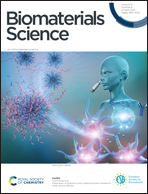Photothermal therapy may be a double-edged sword by inducing the formation of bacterial antibiotic tolerance†
Abstract
Photothermal nanoparticles are thought to be the most suitable candidates against infectious disease by disrupting the cell membrane or inhibiting cellular metabolism. However, cells with low-metabolic activity states may be endowed with greater ability against harsh environments including antibiotic treatment. For now, it remains unexplored whether and how photothermal therapy (PTT) gives rise to bacterial antibiotic tolerance. In this study, we showed that although it exhibits excellent bactericidal ability, PTT with typical photothermal nanoparticle gold nanocages (AuNCs) can give rise to a subpopulation of cells with great ability of antibiotic tolerance. The subpopulation exhibits delayed growth and decreased cellular ATP levels, indicating a low metabolic state. Specifically, after AuNCs attach to the surface of a bacterial cell, photothermal manipulation can induce cell membrane shrinkage and block the bacterial respiratory chain. Besides, heat shock induces protein aggregation and leads to the dysfunction of a number of important proteins. The heat shock protein DnaK is closely associated with protein aggregation and plays a vital role in modulating antibiotic tolerance, providing a potential therapeutic target.



 Please wait while we load your content...
Please wait while we load your content...